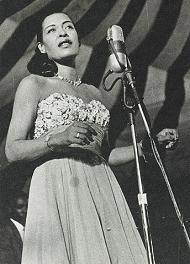Students will learn about the jazz singer Billie Holiday and the sociohistorical context in which she performed. They will learn how discriminatory statutes (called Jim Crow laws) affected daily life. They will also analyze how movement is created in photographs and the effect of a photographer's point of view on composition. Finally, students will photograph a musician, paying attention to what can be communicated through point of view. |
 |
 |
 |
Download the complete lesson by clicking on the "Download this lesson" icon above.
Glossary Terms:
Words in bold on these pages and in the lesson are defined in the glossary for this curriculum (see "Performing Arts in Art Contents" links above). |
 |
 |
 |
| Billie Holiday, Lisette Model, about 1954. © Estate of Lisette Model, courtesy Baudoin Lebon/Keitelman
|
 |
|
 |
Common Core Standards for English Language Arts
Grades 9–12
READING
Key Ideas and Details
1. Read closely to determine what the text says explicitly and to make logical inferences from it; cite specific textual evidence when writing or speaking to support conclusions drawn from the text.
WRITING
Production and Distribution of Writing
4. Produce clear and coherent writing in which the development, organization, and style are appropriate to task, purpose, and audience.
Research to Build and Present Knowledge
7. Conduct short as well as more sustained research projects based on focused questions, demonstrating understanding of the subject under investigation.
8. Gather relevant information from multiple print and digital sources, assess the credibility and accuracy of each source, and integrate the information while avoiding plagiarism.
9. Draw evidence from literary or informational texts to support analysis, reflection, and research.
SPEAKING AND LISTENING
Comprehension and Collaboration
1. Prepare for and participate effectively in a range of conversations and collaborations with diverse partners, building on others' ideas and expressing their own clearly and persuasively.
2. Integrate and evaluate information presented in diverse media and formats, including visually, quantitatively, and orally.
Visual Arts Content Standards for California Public Schools
Grades 9–12 (Proficient)
1.0 Artistic Perception
1.4 Analyze and describe how the composition of a work of art is affected by the use of a particular principle of design.
2.0 Creative Expression
2.1 Solve a visual arts problem that involves the effective use of the elements of art and the principles of design.
3.0 Historical and Cultural Context
3.3 Identify and describe trends in the visual arts and discuss how the issues of time, place, and cultural influence are reflected in selected works of art.
4.0 Aesthetic Valuing
4.1 Articulate how personal beliefs, cultural traditions, and current social, economic, and political contexts influence the interpretation of the meaning or message in a work of art.
Music Content Standards for California Public Schools
Grades 9–12 (Proficient)
3.0 Historical and Cultural Context
3.1 Identify the sources of musical genres of the United States, trace the evolution of those genres, and cite well-known musicians associated with them.
3.2 Explain the various roles that musicians perform, identify representative individuals who have functioned in each role, and explain their activities and achievements.
4.0 Aesthetic Valuing
4.3 Explain how people in a particular culture use and respond to specific musical works from that culture.
History–Social Science Content Standards for California Public Schools
Grade 11
11.8 Students analyze the economic boom and social transformation of post–World War II America.
8. Discuss forms of popular culture, with emphasis on their origins and geographic diffusion (e.g., jazz and other forms of popular music, professional sports, architectural and artistic styles).
|
 |

|
 |


